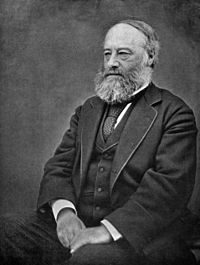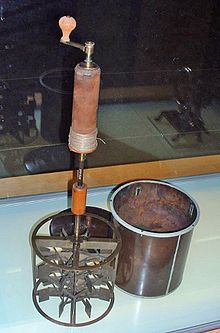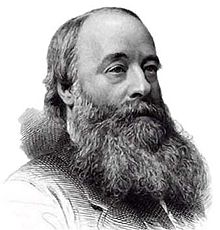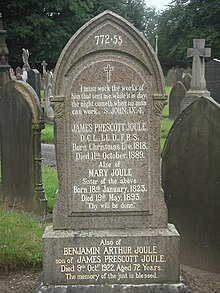ผู้ใช้:Phonexaykvs
ເຈມ ເພຣສຄອດ ຢູນ(James Prescott Joule) | |
|---|---|
 ເຈມສ ຢູນ – ນັກຟີຊິກສາດ | |
| เกิด | Salford, Lancashire, England, UK |
| เสียชีวิต | 11 ตุลาคม ค.ศ. 1889 (70 ปี) Sale, Cheshire, England, UK |
| พลเมือง | British |
| มีชื่อเสียงจาก | First law of thermodynamics Disproving Caloric Theory |
| อาชีพทางวิทยาศาสตร์ | |
| สาขา | Physics |
| มีอิทธิพลต่อ | John Dalton John Davies |
ເຈມສ ເພຣສຄອດ ຢູນ (James Prescott Joule) FRS (/dʒuːl/;[1](24 ທັນວາ 1818 – 11 ຕຸລາ 1889) ແມ່ນ ນັກຟີຊິກສາດ ຊາວອັງກິດ and brewer, born in Salford, Lancashire. Joule studied the nature of heat, and discovered its relationship to mechanical work (see energy). This led to the Law of conservation of energy, and this led to the development of the First law of thermodynamics. The SI derived unit of energy, the joule, is named for James Joule. He worked with Lord Kelvin to develop the absolute scale of temperature. Joule also made observations of magnetostriction, and he found the relationship between the current through a resistor and the heat dissipated, which is now called Joule's first law.
Early years
[แก้]The son of a wealthy brewer, Joule was tutored as a young man by the famous scientist John Dalton and was strongly influenced by chemist William Henry and Manchester engineers Peter Ewart and Eaton Hodgkinson. He was fascinated by electricity, and he and his brother experimented by giving electric shocks to each other and to the family's servants.
As an adult, Joule managed the brewery. Science was merely a serious hobby. Sometime around 1840, he started to investigate the feasibility of replacing the brewery's steam engines with the newly-invented electric motor. His first scientific papers on the subject were contributed to William Sturgeon's Annals of Electricity.
Motivated in part by a business man's desire to quantify the economics of the choice, and in part by his scientific inquisitiveness, he set out to determine which prime mover was the more efficient. He discovered Joule's first law in 1841, that the heat which is evolved by the proper action of any voltaic current is proportional to the square of the intensity of that current, multiplied by the resistance to conduction which it experiences.[2] He went on to realise that burning a pound of coal in a steam engine was more economical than a costly pound of zinc consumed in an electric battery. Joule captured the output of the alternative methods in terms of a common standard, the ability to raise one pound, a height of one foot, the foot-pound.
However, Joule's interest diverted from the narrow financial question to that of how much work could be extracted from a given source, leading him to speculate about the convertibility of energy. In 1843 he published results of experiments showing that the heating effect he had quantified in 1841 was due to generation of heat in the conductor and not its transfer from another part of the equipment. This was a direct challenge to the caloric theory which held that heat could neither be created or destroyed. Caloric theory had dominated thinking in the science of heat since introduced by Antoine Lavoisier in 1783. Lavoisier's prestige and the practical success of Sadi Carnot's caloric theory of the heat engine since 1824 ensured that the young Joule, working outside either academia or the engineering profession, had a difficult road ahead. Supporters of the caloric theory readily pointed to the symmetry of the Peltier-Seebeck effect to claim that heat and current were convertible in an, at least approximately, reversible process.
The mechanical equivalent of heat
[แก้]Further experiments and measurements by Joule led him to estimate the mechanical equivalent of heat as 838 ft·lbf of work to raise the temperature of a pound of water by one degree Fahrenheit.[3] He announced his results at a meeting of the chemical section of the British Association for the Advancement of Science in Cork in August 1843 and was met by silence.[4]
Joule was undaunted and started to seek a purely mechanical demonstration of the conversion of work into heat. By forcing water through a perforated cylinder, he was able to measure the slight viscous heating of the fluid. He obtained a mechanical equivalent of 770 ft·lbf/Btu (4.14 J/cal). The fact that the values obtained both by electrical and purely mechanical means were in agreement to at least one order of magnitude was, to Joule, compelling evidence of the reality of the convertibility of work into heat.
Joule now tried a third route. He measured the heat generated against the work done in compressing a gas. He obtained a mechanical equivalent of 798 ft·lbf/Btu (4.29 J/cal).[5] In many ways, this experiment offered the easiest target for Joule's critics but Joule disposed of the anticipated objections by clever experimentation. However, his paper was rejected by the Royal Society and he had to be content with publishing in the Philosophical Magazine. In the paper he was forthright in his rejection of the caloric reasoning of Carnot and Émile Clapeyron, but his theological motivations also became evident:
I conceive that this theory ... is opposed to the recognised principles of philosophy because it leads to the conclusion that vis viva may be destroyed by an improper disposition of the apparatus: Thus Mr Clapeyron draws the inference that 'the temperature of the fire being 1000 °C to 2000 °C higher than that of the boiler there is an enormous loss of vis viva in the passage of the heat from the furnace to the boiler.' Believing that the power to destroy belongs to the Creator alone I affirm ... that any theory which, when carried out, demands the annihilation of force, is necessarily erroneous.
Joule here adopts the language of vis viva (energy), possibly because Hodgkinson had read a review of Ewart's On the measure of moving force to the Literary and Philosophical Society in April 1844.
In 1845, Joule read his paper On the mechanical equivalent of heat to the British Association meeting in Cambridge.[6] In this work, he reported his best-known experiment, involving the use of a falling weight, in which gravity does the mechanical work, to spin a paddle-wheel in an insulated barrel of water which increased the temperature. He now estimated a mechanical equivalent of 819 ft·lbf/Btu (4.41 J/cal).
Joule wrote in his 1845 paper:
... the mechanical power exerted in turning a magneto-electric machine is converted into the heat evolved by the passage of the currents of induction through its coils; and, on the other hand, that the motive power of the electro-magnetic engine is obtained at the expense of the heat due to the chemical reactions of the battery by which it is worked.[7]

In 1850, Joule published a refined measurement of 772.692 ft·lbf/Btu (4.159 J/cal), closer to twentieth century estimates.[8]
Reception and priority
[แก้]
- For the controversy over priority with Mayer, see Mechanical equivalent of heat: Priority
Much of the initial resistance to Joule's work stemmed from its dependence upon extremely precise measurements. He claimed to be able to measure temperatures to within 1200 of a degree Fahrenheit (3 mK). Such precision was certainly uncommon in contemporary experimental physics but his doubters may have neglected his experience in the art of brewing and his access to its practical technologies.[9] He was also ably supported by scientific instrument-maker John Benjamin Dancer. Joule's experiments complemented the theoretical work of Rudolf Clausius, who is considered by some to be the coinventor of the energy concept.
Joule was proposing a kinetic theory of heat (he believed it to be a form of rotational, rather then translational, kinetic energy), and this required a conceptual leap: if heat was a form of molecular motion, why didn't the motion of the molecules gradually die out? Joule's ideas required one to believe that the collisions of molecules were perfectly elastic. We should also remember that the very existence of atoms and molecules was not widely accepted for another hundred years.
Although it may be hard today to understand the allure of the caloric theory, at the time it seemed to have some clear advantages. Carnot's successful theory of heat engines had also been based on the caloric assumption, and only later was it proved by Lord Kelvin that Carnot's mathematics were equally valid without assuming a caloric fluid.
However, in Germany, Hermann Helmholtz became aware both of Joule's work and the similar 1842 work of Julius Robert von Mayer. Though both men had been neglected since their respective publications, Helmholtz's definitive 1847 declaration of the conservation of energy credited them both.
Also in 1847, another of Joule's presentations at the British Association in Oxford was attended by George Gabriel Stokes, Michael Faraday, and the precocious and maverick William Thomson, later to become Lord Kelvin, who had just been appointed professor of natural philosophy at the University of Glasgow. Stokes was "inclined to be a Joulite" and Faraday was "much struck with it" though he harboured doubts. Thomson was intrigued but sceptical.
Unanticipated, Thomson and Joule met later that year in Chamonix. Joule married Amelia Grimes on 18 August and the couple went on honeymoon. Marital enthusiasm notwithstanding, Joule and Thomson arranged to attempt an experiment a few days later to measure the temperature difference between the top and bottom of the Cascade de Sallanches waterfall, though this subsequently proved impractical.
Though Thomson felt that Joule's results demanded theoretical explanation, he retreated into a spirited defence of the Carnot-Clapeyron school. In his 1848 account of absolute temperature, Thomson wrote that "the conversion of heat (or caloric) into mechanical effect is probably impossible, certainly undiscovered"[10] – but a footnote signalled his first doubts about the caloric theory, referring to Joule's "very remarkable discoveries". Surprisingly, Thomson did not send Joule a copy of his paper but when Joule eventually read it he wrote to Thomson on 6 October, claiming that his studies had demonstrated conversion of heat into work but that he was planning further experiments. Thomson replied on the 27th, revealing that he was planning his own experiments and hoping for a reconciliation of their two views. Though Thomson conducted no new experiments, over the next two years he became increasingly dissatisfied with Carnot's theory and convinced of Joule's. In his 1851 paper, Thomson was willing to go no further than a compromise and declared "the whole theory of the motive power of heat is founded on ... two ... propositions, due respectively to Joule, and to Carnot and Clausius".
As soon as Joule read the paper he wrote to Thomson with his comments and questions. Thus began a fruitful, though largely epistolary, collaboration between the two men, Joule conducting experiments, Thomson analysing the results and suggesting further experiments. The collaboration lasted from 1852 to 1856, its discoveries including the Joule-Thomson effect, and the published results did much to bring about general acceptance of Joule's work and the kinetic theory.
Kinetic theory
[แก้]
Kinetics is the science of motion. Joule was a pupil of Dalton and it is no surprise that he had learned a firm belief in the atomic theory, even though there were many scientists of his time who were still skeptical. He had also been one of the few people receptive to the neglected work of John Herapath on the kinetic theory of gases. He was further profoundly influenced by Peter Ewart's 1813 paper On the measure of moving force.
Joule perceived the relationship between his discoveries and the kinetic theory of heat. His laboratory notebooks reveal that he believed heat to be a form of rotational, rather than translational motion.
Joule could not resist finding antecedents of his views in Francis Bacon, Sir Isaac Newton, John Locke, Benjamin Thompson (Count Rumford) and Sir Humphry Davy. Though such views are justified, Joule went on to estimate a value for the mechanical equivalent of heat of 1034 foot-pound from Rumford's publications. Some modern writers have criticised this approach on the grounds that Rumford's experiments in no way represented systematic quantitative measurements. In one of his personal notes, Joule contends that Mayer's measurement was no more accurate than Rumford's, perhaps in the hope that Mayer had not anticipated his own work. Joule has been attributed with explaining the Green Flash phenomenon in a letter to the Manchester Literary and Philosophical Society in 1869: actually, he just noted (with a sketch) the last glimpse as bluish green.[11]
Honours
[แก้]

Joule died at home in Sale[12] and is buried in Brooklands cemetery there. The gravestone is inscribed with the number "772.55", his climacteric 1878 measurement of the mechanical equivalent of heat, in which he found that this amount of foot-pounds of work must be expended at sea level to raise the temperature of one pound of water from 60 to 61 F. There is also a quotation from the Gospel of John, "I must work the works of him that sent me, while it is day: the night cometh, when no man can work" (9:4). The Wetherspoon's public house in Sale, the town of his death, is named after him "The J P Joule". The family brewery still lives on but now located in Market Drayton (see joulesbrewery.co.uk for more information on origins).
A bust of him, by John Cassidy, can be found in Worthington Park, Sale. Further details of this work can be found at http://www.johncassidy.org.uk/joule.html.
- Fellow of the Royal Society, (1850);
- Royal Medal, (1852);
- Copley Medal (1870);
- President of Manchester Literary and Philosophical Society, (1860);
- President of the British Association for the Advancement of Science, (1872, 1887);
- Honorary Membership of the Institution of Engineers and Shipbuilders in Scotland[1], (1857);
- Honorary degrees:
- LL.D., Trinity College Dublin, (1857);
- DCL, University of Oxford, (1860);
- LL.D., University of Edinburgh, (1871).
- He received a civil list pension of £200 per annum in 1878 for services to science;
- Albert Medal of the Royal Society of Arts, (1880).
- There is a memorial to Joule in the north choir aisle of Westminster Abbey, though he is not buried there, contrary to what some biographies state.
- A statue by Alfred Gilbert, stands in Manchester Town Hall, opposite that of Dalton.
Selected writings
[แก้]- Joule, J. P. (1884). The Scientific Papers of James Prescott Joule. London: Physical Society.
Notes
[แก้]- ↑ OED: (a.k.a. Jimmy Jewell) "Although some people of this name call themselves (dʒaʊl), and others (dʒəʊl) [the OED format for /dʒoʊl/], it is almost certain that J. P. Joule (and at least some of his relatives) used (dʒuːl). The Joule brewery used the confusion in its pronunciation in advertising: Childs, Stephen. "Chemical Miscellany". Chemistry in Action!. University of Limerick (50). สืบค้นเมื่อ 24 มีนาคม 2010.
- ↑ Joule, J P (1841). "On the Heat evolved by Metallic Conductors of Electricity, and in the Cells of a Battery during Electrolysis". Philosophical Magazine. 19: 260. doi:10.1080/14786444108650416. สืบค้นเมื่อ 3 มีนาคม 2014.
- ↑ Joule's unit corresponds to 5.3803×10−3 J/cal. Thus Joule's estimate was 4.51 J/cal, compared to the value accepted by the beginning of the 20th century of 4.1860 J/cal (M.W. Zemansky (1968) Heat and Thermodynamics, 5th ed., p. 86).
- ↑ Joule, J. P. (1843). "On the Calorific Effects of Magneto-Electricity, and on the Mechanical Value of Heat". Philosophical Magazine. 3. 23: 263, 347 & 435. สืบค้นเมื่อ 4 มีนาคม 2014.
- ↑ Joule, J.P. (1845) "On the Changes of Temperature produced by the Rarefaction and Condensation of Air" Philosophical Magazine, Scientific Papers p172
- ↑ Joule, J.P. (1845) "On the Mechanical Equivalent of Heat", Brit. Assoc. Rep., trans. Chemical Sect, p.31, read before the British Association at Cambridge, June
- ↑ Joule, James Prescott (1845). "On the Changes of Temperature Produced by the Rarefaction and Condensation of Air". Philosophical Magazine Series 3. Harper & brothers. 26.
- ↑ Joule, J.P (1 January 1850) "On the mechanical equivalent of heat," Philosophical Transactions of the Royal Society of London, vol.140, Part 1, pages 61–82.
- ↑ Sibum (1994)
- ↑ See Thomson, William (1848). "On an Absolute Thermometric Scale founded on Carnot's Theory of the Motive Power of Heat, and calculated from Regnault's Observations". Philosophical Journal.- See also the account in Thomson, William (1882). Mathematical and Physical Papers. Cambridge, England: Cambridge University Press. pp. 100–106.
- ↑ Proc. Manchester Lit. Phil. Soc. 9, 1 (1869) On an appearance of the setting sun reprinted as On Sunset seen at Southport
- ↑ GRO Register of Deaths: DEC 1889 8a 121 ALTRINCHAM – James Prescott Joule
Further reading
[แก้]- Bottomley, J. T. (1882). "James Prescott Joule". Nature. 26 (678): 617–620. Bibcode:1882Natur..26..617B. doi:10.1038/026617a0.
- Cardwell, D. S. L. (1991). James Joule: A Biography. Manchester college Press. ISBN 0-7190-3479-5.
- Forrester, J. (1975). "Chemistry and the Conservation of Energy: The Work of James Prescott Joule". Studies in the History and Philosophy of Science. 6 (4): 273–313. doi:10.1016/0039-3681(75)90025-4.
- Fox, R, "James Prescott Joule, 1818–1889", in North, J. (1969). Mid-nineteenth-century scientists. Elsevier. pp. 72–103. ISBN 0-7190-3479-5.
- Reynolds, Osbourne (1892). Memoir of James Prescott Joule. Manchester, England: Manchester Literary and Philosophical Society. สืบค้นเมื่อ 15 มีนาคม 2008.
- Sibum, H. O. (1995). "Reworking the mechanical value of heat: instruments of precision and gestures of accuracy in early Victorian England". Studies in History and Philosophy of Science. 26: 73–106. doi:10.1016/0039-3681(94)00036-9.
- Smith, C. (1998). The Science of Energy: A Cultural History of Energy Physics in Victorian Britain. London: Heinemann. ISBN 0-485-11431-3.
- แม่แบบ:ODNBweb. แม่แบบ:DNBfirst
- Smith, C. & Wise, M.N. (1989). Energy and Empire: A Biographical Study of Lord Kelvin. Cambridge University Press. ISBN 0-521-26173-2.
{{cite book}}: CS1 maint: multiple names: authors list (ลิงก์) - Steffens, H.J. (1979). James Prescott Joule and the Concept of Energy. Watson. ISBN 0-88202-170-2.
- Walker, James (1950). Physics 4th Edition. Pearson. ISBN 978-0-321-54163-5.
External links
[แก้][[:s:|]]
- The scientific papers of James Prescott Joule (1884) - annotated by Joule
- The joint scientific papers of James Prescott Joule (1887) - annotated by Joule
- Classic papers of 1845 and 1847 at ChemTeam website On the Mechanical Equivalent of Heat and On the Existence of an Equivalent Relation between Heat and the ordinary Forms of Mechanical Power
- Joule's water friction apparatus at London Science Museum
- Some Remarks on Heat and the Constitution of Elastic Fluids, Joule's 1851 estimate of the speed of a gas molecule.
- University of Manchester material on Joule – includes photographs of Joule's house and gravesite
- . Dictionary of National Biography (ภาษาอังกฤษ). London: Smith, Elder & Co. 1885–1900.
- "Dr. Joule". Electrical Engineer. London: Biggs & Co (18 October): 311–312. 1889. สืบค้นเมื่อ 16 พฤษภาคม 2008.- obituary with brief comment on Joule's family
- Joule Physics Laboratory at the University of Salford
- [2] - contains further information on the origins of the Joules brewery and the link with James Prescott Joule
แม่แบบ:Copley Medallists 1851–1900 แม่แบบ:Scientists whose names are used as SI units
| [[วิกิพีเดีย:|ข้อมูลบุคคล]] | |
|---|---|
| ชื่อ | ຢູນ ເຈມາ ເພຣສຄອດ (Joule, James Prescott)} |
| ชื่ออื่น | |
| รายละเอียดโดยย่อ | British physicist |
| วันเกิด | 24 ທັນວາ 1818 |
| สถานที่เกิด | Salford, Lancashire, England |
| วันตาย | 11 ຕຸລາ 1889 |
| สถานที่ตาย | Sale, Cheshire, England |
